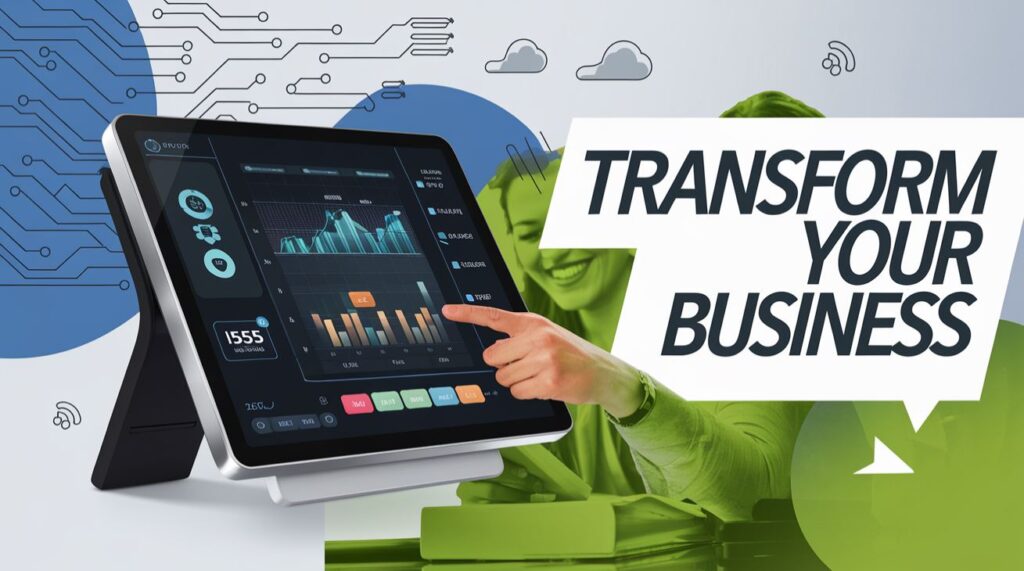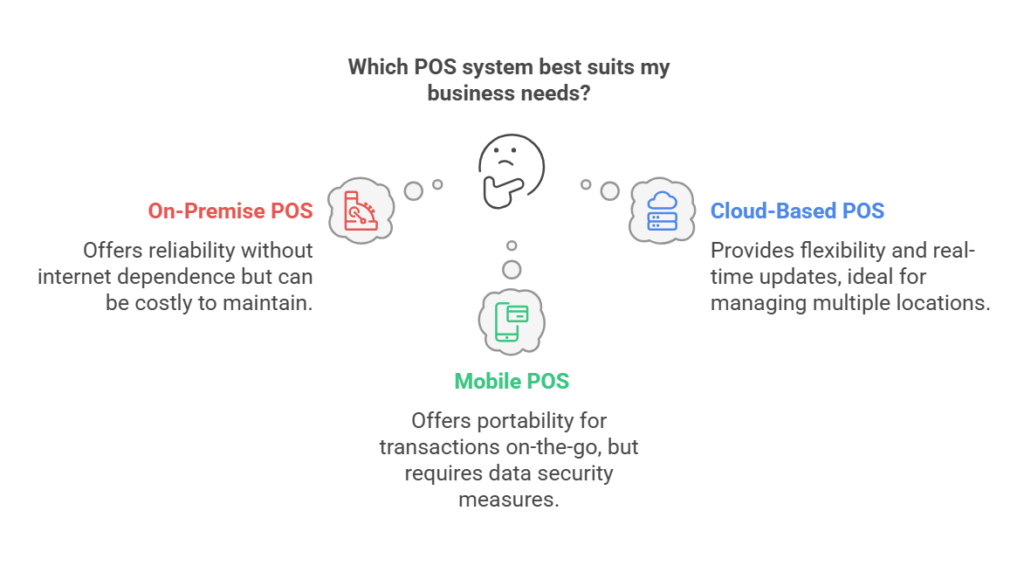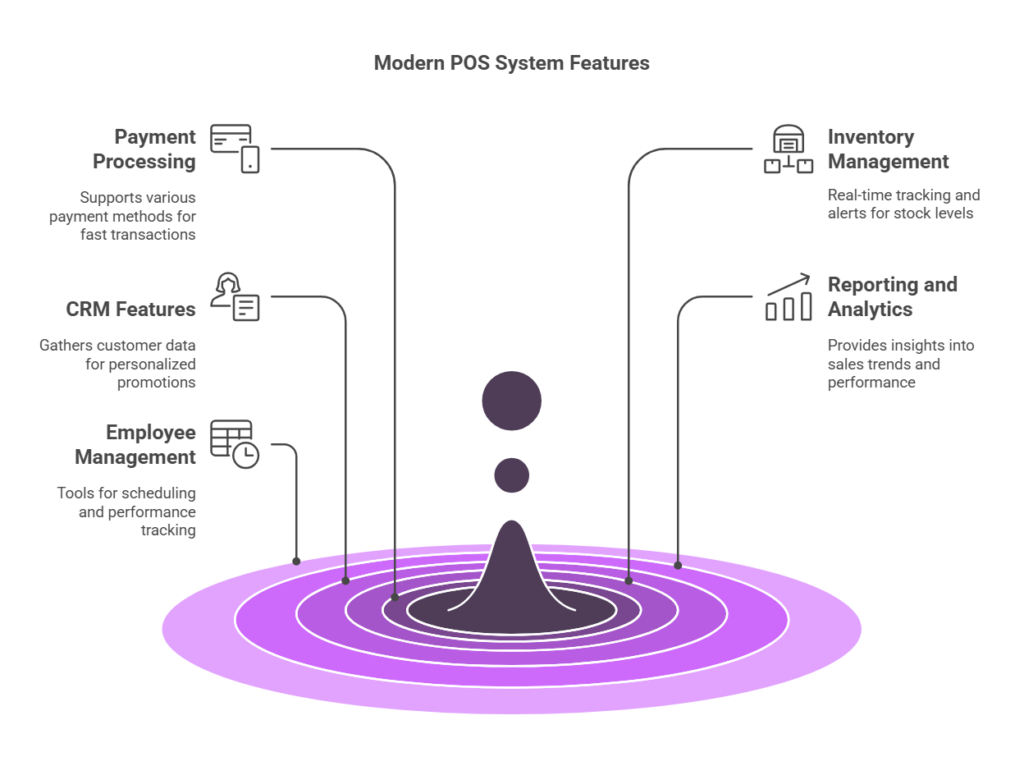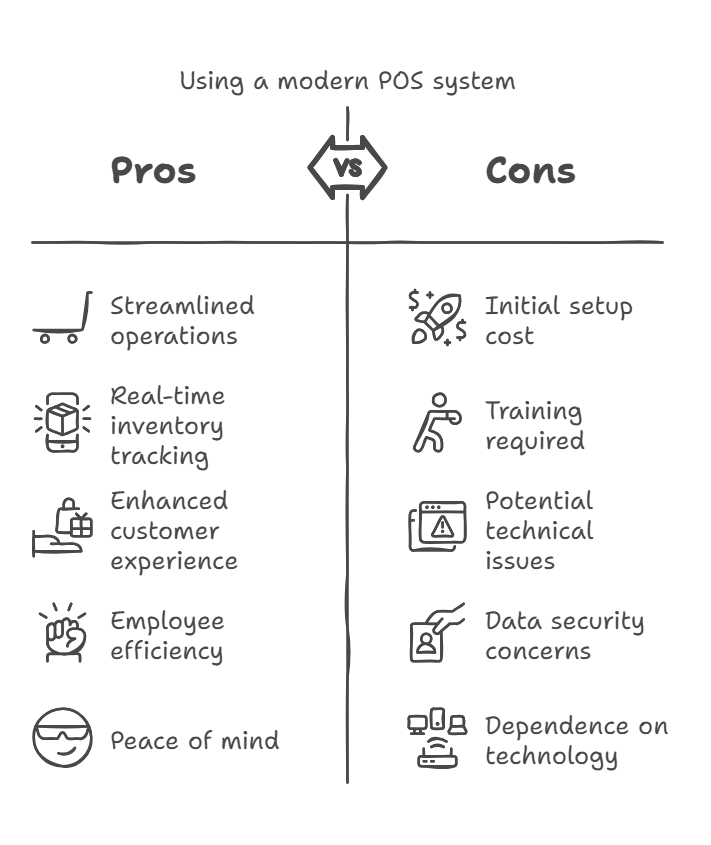Have you ever noticed how some businesses seem to operate seamlessly even during busy periods? Imagine a world in which every sale, inventory update and customer interaction is easily managed by one smart system – that’s the magic of modern Point-of-Sale (POS) systems! In this guide, you will discover how embracing the right POS solution can completely change the game for your business; at its heart lies creating an enjoyable and hassle-free customer experience through technology. Let’s dive deeper into this tale, uncover its intricate plot twists and discover this powerful business tool together.
Imagine this: As the owner of a cozy boutique with a loyal customer base, you find yourself struggling to manage sales, inventory, and customer data across multiple systems – like trying to solve a puzzle made up of too many pieces. That was me several years ago until I discovered the power of a modern POS system.
A POS system is more than just a cash register – it’s an integrated solution designed to streamline operations, boost efficiency, and create an enhanced customer experience. Imagine swift transactions processed quickly while inventory updates in real time, as well as tailored marketing efforts based on actual customer behavior, all happening from one central place! Sounds idealistic, but that dream can become reality today with the right POS solution in place!
But finding such a system was challenging: my goal was to find something that could do all of that without becoming overly complex. Therefore, I set off on an exploration to uncover what truly makes a POS system effective; not simply hardware or software—but how these components come together to overcome everyday obstacles. By the time you reach the end of this guide you’ll see that a carefully chosen POS can become the beating heart of your business, keeping everything working seamlessly. Let’s embark together on this exciting journey.
Understanding Point of Sale (POS) Systems
When I think back on POS systems, I remember when cash registers were all you needed to run a store. These were simpler times of clunky machines and manual bookkeeping; as my business expanded so did its complexity—at which point a traditional cash register just couldn’t keep pace with modern business needs.
Early POS systems were relatively basic. They simply processed sales transactions and recorded cash transactions; as technology advanced, so too did the need for more robust solutions. Modern POS systems now serve as intelligent platforms that manage transactions, track inventory, and gather customer insights—yet this evolution wasn’t without challenges as businesses struggled with disconnected systems barely communicating among themselves; but with integrated, cloud-based POS solutions entering the picture, businesses now enjoy smooth operations.
Modern POS systems now provide real-time updates, seamless data integration, and advanced reporting features to adapt to a range of industries—whether that’s retail stores, restaurants, or pop-up shops at local events. This development marks a substantial shift away from outdated methods of doing business to one where technology frees you to focus on building lasting relationships with your customers instead.
Switching from traditional to modern POS systems can be daunting, and transitioning can be especially harrowing when faced with these questions: “how do I select features appropriate to my operations, ensure seamless integration and maintain functionality?” In my own experience I discovered that understanding POS technology’s history is key in making informed decisions—as we journey together, you’ll understand why modern POS systems form the core of successful business ecosystems.
Types of POS Systems
When first upgrading business operations, the abundance of point of sale systems available might seem like an intimidating obstacle course. I remember gazing upon numerous systems promising to be the ideal match for my store—like staring into an endless buffet! But which will truly offer efficiency and growth potential for you?
There are various POS systems on the market today, each with its own set of benefits. Traditional on-premise POS systems offer reliability without depending on an internet connection for basic operations; however, their ongoing upkeep and upgrades can be costly to manage. I personally experienced firsthand how vulnerable my team became due to an outage; it served as a wakeup call—technology must be as resilient as your business.
But then I discovered cloud-based POS systems. These innovative solutions store your data on secure remote servers and provide real-time updates from anywhere—giving me the flexibility I needed to manage multiple store locations and online sales seamlessly. If accessibility and scalability are important to you, a cloud-based system might be your ideal choice.
Mobile POS systems offer another exciting option for sales transactions at pop-up markets or bustling events. Mobile systems transform your smartphone or tablet into an efficient POS, offering incredible portability. However, with such freedom comes the responsibility to protect data over wireless networks—something every tech-savvy business owner must consider carefully.
Each POS system comes with its own set of advantages and disadvantages, so it’s crucial that you assess your unique business needs before making your selection. I learned that understanding these questions is the key to selecting a system that not only fits but enhances your business—with the right POS system in place, obstacles can quickly turn into opportunities!
Essential Features of Modern POS Systems
As soon as I started using a modern POS system for my business, I was amazed to discover its vast array of features that went far beyond simply processing sales. It felt like opening an entire toolbox that contained everything needed to run my company more effectively—though my journey wasn’t without bumps: initially, there seemed like too many features and options; each feature seemed like it could potentially revolutionize operations but I wasn’t sure how they all fitted together.
Let’s first consider payment processing. Modern POS systems support various payment methods—from cash and credit cards, mobile, contactless payments as well as cashless options. Fast transactions create happier customers. Reduced wait times lead to increased satisfaction, whereas failing systems cause frustration among your customers.
Real-time inventory management is another essential feature. Imagine having a system that updates your stock instantly after every sale happens; I know firsthand the stress caused when inventory data was outdated by one day! Therefore, an advanced POS offering live tracking of inventory levels, automated alerts for low stock levels, and supplier integration is more than merely convenient; it’s necessary.
Customer Relationship Management (CRM) features make an impactful statement about your organization. They enable you to gather customer data, track buying habits, and launch personalized promotions—but remember, it’s not enough just to collect data; actionable insights must drive loyalty and repeat business.
Robust reporting and analytics are an indispensable asset to my business strategy, providing invaluable insight into sales trends, peak hours, and product performance—giving me enough data to alter my strategy effectively and make any necessary tweaks to ensure its success. Without them, however, you’d be flying blind.
Employee management tools add another level of efficiency. From scheduling, time tracking, and performance monitoring to morale-building features like scheduling meetings or timekeeping logs—each feature contributes to smoother operation. Investing in a POS system with these features is not simply about technology—it is about creating an enjoyable customer experience! With a well-equipped POS system, you are not simply making sales; rather you are building a sustainable data-driven enterprise ready to face whatever comes its way.
Benefits of Using a POS System
I understand firsthand the challenges associated with managing a growing business can be extremely stressful. From paperwork, inventory control issues, and long checkout queues—it all adds up. But imagine having access to an effective tool that transforms these problems into triumphs: this is exactly what a modern POS system can provide!
POS systems can dramatically streamline operations, with transactions processed quickly to reduce wait times and satisfy customers more effectively. I recall the relief I felt as my first seamless sale processed in seconds—an experience which redefined efficiency for me. Fast processing doesn’t just refer to speed; accuracy should also become part of your daily operations.
Inventory management can be transformative. With real-time tracking, inventory headaches have been replaced by automated alerts and insights that guided my purchasing decisions based on real data analytics. Every decision now rests upon solid, real-time information to support it.
POS systems also significantly enhance customer experiences. Imagine creating an environment in which customers feel truly appreciated as their preferences are recognized and met through tailored offers created using integrated CRM features. Furthermore, employees become more efficient and motivated when freed from tedious tasks; creating an atmosphere conducive to repeat business and loyalty among your customer base.
Every challenge I encountered before adopting a POS system eventually turned into an opportunity, so the benefits are more than operational; they’re transformational as they allow businesses to focus on growth and innovation. But ultimately, peace of mind was what really made a POS system indispensable—something no amount of operational benefits could do!
How to Choose the Right POS System for Your Business
Finding a point-of-sale (POS) system should feel like finding your dream pair of shoes: everything has to fit perfectly. I understand the frustration associated with browsing endless options, feeling as though each system promised everything yet had their own set of flaws; yet this journey is essential—selecting an effective POS can become the backbone of your business while choosing an ineffective one could turn everyday tasks into daunting obstacles.
First, assess your business needs. Are you operating a single storefront or multiple locations, with or without an online presence? Having a thorough understanding of your operations is vital; I remember feeling frustrated trying to force a generic solution onto my unique business model. However, once I understood exactly what features my requirements demanded—fast transactions, real-time inventory, and seamless CRM—I knew exactly which software provider would meet those criteria.
Once again, compare traditional on-premise systems with cloud-based and mobile options. Traditional systems provide stability but may lack the scalability offered by cloud-based systems that offer remote access and real-time updates; mobile solutions offer portability, which makes them suitable for pop-up shops or events. Each has its own benefits as well as drawbacks; your decision should depend on which option best meets the demands of daily operations—always weigh cost against functionality when making this choice. I once overspent on an expensive system only to discover it wasn’t needed after purchasing all its features!
User experience is of utmost importance. An intuitive system can save hours in training and troubleshooting; and don’t overlook customer support! Reliable assistance when technical glitches arise can make the difference between success and failure. Look for vendors known for exceptional service and scalability so your system grows with your business.
An effective point-of-sale (POS) system is more than a mere purchase: it’s an investment in your future. Therefore, take the time to carefully evaluate, test, and choose. Although selecting one may seem daunting at first, once you find one you love you’ll wonder how you ever managed without it! I guarantee it; finding your ideal POS can transform your business life and make every transaction easier and every day brighter.
Trends and Innovations in POS Technology
Technology is constantly advancing, including point of sale (POS) systems. I can remember when digital payments first became mainstream with smartphones beginning to influence our lives; now fast forward to present day—innovations in POS tech have been nothing short of revolutionary. One exciting trend is mobile/contactless payment methods which make payments fast, secure, and hassle-free—perfect for today’s fast-paced society! POS isn’t simply cool; it is an absolute necessity in today’s fast world!
Modern POS systems have continued to advance. Today’s systems are fully integrated with e-commerce platforms, creating seamless sales experiences across online and offline sales channels. Once I realized this, it significantly reduced headaches. Businesses can now track every sale made both in-store and online with real-time inventory management solutions—an integration that has turned chaos into order by providing informed business decisions for business owners.
Artificial Intelligence (AI) and machine learning technologies have quickly made an impression in recent years. These technologies help predict trends, personalize customer experiences, optimize pricing strategies, and minimize revenue loss for businesses. But with great power comes great responsibility: modern systems implement robust encryption and compliance features to safeguard sensitive information.
Cloud-based POS solutions add another innovative layer. Offering remote access and real-time updates from anywhere around the globe, cloud POS systems offer businesses that operate multiple locations or plan to expand an ideal solution. However, every advantage comes with its own drawback; ensuring a safe, reliable connection is crucial. Therefore, investing in a system with strong support and continuous updates should be prioritized as one way forward.
Consider your POS system as an active partner who adapts to changes, overcomes obstacles, and propels your business into the future. Mobile tech, AI, and cloud connectivity are not simply trends but rather indications of the direction your business should take—you are the one responsible for shaping this future!
Challenges and Considerations
Every journey comes with its share of challenges, and implementing a modern POS system was no exception. I experienced everything from system downtimes to integrating new tech seamlessly. At first, it felt like wrestling with an unpredictable beast; but each obstacle taught me valuable lessons about resilience and innovation.
One major challenge lies in data security. In an age when cyber threats are constantly on the rise, safeguarding customer data must remain paramount. I once encountered a minor security breach which made me reconsider my system’s safeguards—this incident proved pivotal; since then I prioritize systems with strong encryption, regular updates, and compliance with industry standards like PCI DSS.
Downtime can also be a challenge: imagine being surprised when your POS system freezes during rush hour! I know this firsthand; my stress was palpable until I discovered solutions with reliable backup systems and dedicated customer support—such as quality hardware with backup plans in place—that allowed for uninterrupted business operations.
Employee training can be a challenging aspect of change management. Transitioning to a new system can be daunting for teams used to the old ways; I remember initially facing resistance from some staff members. However, with patience, personalized training sessions, and clear communications about benefits, we successfully transitioned them from skeptical users into enthusiastic supporters of our initiative. Change management is more than a phase—it should be seen as an ongoing process that ultimately strengthens your business.
Every challenge presents an opportunity. By meeting obstacles head-on and using them as learning experiences, you can turn them into steps toward your success. Your POS system, with all its sophisticated features, becomes not just a tool but a trusted partner that grows alongside your business. So embrace any obstacles as learning experiences and watch as your company transforms into an efficient machine!
Case Studies and Success Stories
Let me share a few real-life success stories you may recognize: Imagine a busy retail store where every day felt like a battle against chaos—inventory was mismanaged, sales weren’t realized, and customer frustration mounted. This was the reality for one local business owner until they invested in an up-to-date POS system and suddenly transactions became smoother, inventory levels updated in real time, and customer stress subsided—all within 12 months! By embracing technology that solved real-world problems, the store saw a dramatic 20 percent jump in sales within 12 months!
I have witnessed a restaurant completely transform its operations by adopting a customized POS system. Long waits and mixed orders were once commonplace, but customer satisfaction skyrocketed once this system was in place to manage table orders, integrate CRM tools, streamline the dining experience, and manage table orders with CRM integration. While initially there may have been challenges, training and support services were added to turn those early setbacks into success stories.
Small boutiques also saw success bridging in-store and online sales by adopting mobile POS systems, eliminating concerns over inaccurate inventory data and missed sales opportunities, while providing real-time updates and seamless integration to ensure each sale was recorded, customers felt valued, and the customer experience was transformed for future-proof operations. Every business success begins with taking a leap of faith; these businesses learned that finding the ideal POS system goes far beyond transaction recording—it transforms customer experiences while creating future-proof operations.
These stories demonstrate how modern POS technology can turn everyday challenges into opportunities for growth. Each challenge should be seen as an opportunity to be exploited.
Conclusion
Imagine looking back over your business experience and realizing that every sale, customer interaction, and inventory update was handled effortlessly thanks to a modern POS system. That is the transformative power of modern POS; it’s not simply about technology—but about creating an easier, more enjoyable business journey overall.
Along our journey, we examined the evolution and diversity of POS systems; their essential features; and the challenges they presented—facing them head-on and learning that every obstacle was an opportunity in disguise. At the end of it all was one clear takeaway: a modern POS system is at the core of any successful business, enabling its owner to overcome obstacles and enjoy success.
As you consider making a change, keep this in mind: choosing an effective POS system will not only streamline operations but will have lasting positive repercussions for customer experience and overall growth. So choose wisely, invest in technology that meets your business needs, and watch as every transaction moves toward creating a brighter future for all involved.
Your future lies within your hands. Let your business shine with every sale, every moment, and every connection. Don’t waste this opportunity. Now is the time!
FAQs
What Is A Point-Of-Sale (POS) System?
Point of Sale (POS) system is an integrated hardware and software solution designed to facilitate sales transactions, manage inventory, collect customer information, and enable more informed business decisions. POS systems allow businesses to seamlessly process sales transactions while making every sale data-driven.
How can cloud-based POS systems differ from traditional on-premise systems?
Cloud-based systems store data remotely and offer real-time updates from anywhere, making them highly adaptable and scalable. Traditional systems, installed locally and more rigid in design, tend to provide reliability without needing constant internet connectivity.
Which are the essential features I should search for in a modern POS system?
Features that help streamline operations and increase efficiency include multi-payment processing, real-time inventory tracking, CRM integration, detailed reporting capabilities, and employee management tools. All these work in harmony to optimize operational efficiencies.
How can a POS system improve my customer experience?
By streamlining transactions, reducing errors, and tailoring marketing efforts specifically to each individual customer’s preferences, a POS system helps make them feel valued—turning potential moments of irritation into moments of delight!
What should I consider when selecting a POS system for my business?
To select an effective system that suits both operational challenges and future growth plans, carefully assess your individual business requirements when choosing from traditional, cloud-based, or mobile POS options available today. Think about costs, scalability, and customer support as you evaluate different systems on offer; compare costs between traditional, cloud-based, and mobile POS options before making your selection.




